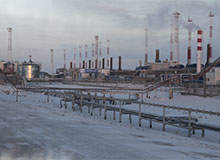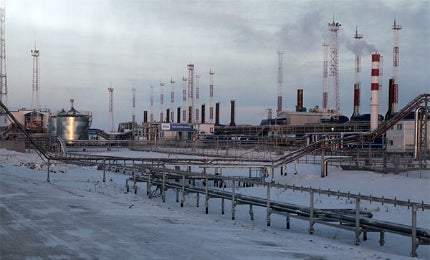
The Zapolyarnoye oil, gas and condensate field is located 220km away from Novy Urengoy, in the southern Taz District of Yamal-Nenets Autonomous Area, Russia. Commercial production from the field began in 2001. Zapolyarnoye is owned and operated by the Russian state-owned energy giant Gazprom.
With an initial reserve of 3.5 trillion m³ of gas, 60 million tonnes of gas condensate and 20 million tonnes of oil, Zapolyarnoye ranks as the world’s sixth largest oil and gas field.
Zapolyarnoye has now become the most productive field in Russia with the commissioning of its fifth comprehensive gas treatment unit (CGTU) and the third compressor workshop at the Zapolyarnaya main compressor station (MCS) at the beginning of 2013.
The gas field has been brought to its full design capacity of 130 billion m3 of gas per year. The field reached the trillion cubic metres production mark in December 2012.
Cenomanian and Valanginian deposits
The Zapolyarnoye field is relatively compact in size. It is spread over an area of 8,745ha. The length and width of the field are 50km and 30km respectively.
The gas field mainly comprises of two deposits, namely Cenomanian and Valanginian. Cenomanian deposit was developed first as part of the Zapolyarnoye development project.
Raw hydrocarbons from Zapolyarnoye are produced by five CGTUs. Three CGTUs treat gas from the Cenomanian deposits and two CGTUs treat gas from Valanginian deposits.
Gas produced from the field is transported to the market through the 190km Zapolyarnoye – Urengoy gas trunkline system (GTS). The GTS comprises of four pipelines, each with a diameter of 1.4m and eight compressor workshops (three at the Zapolyarnaya MCS, four at the Purtazovskaya CS and one at the Novo-Urengoyskaya MCS).
History of Russia’s Zapolyarnoye field
The Zapolyarnoye field, which forms a part of the Western Siberia oil and gas bearing province, was discovered in 1965. An agreement was signed between the Taz District Administration and Gazprom Dobycha Yamburg, a wholly owned subsidiary of Gazprom, in 1992 to develop the field for commercial production.
The gas field development started in March 1994. Gas production from the Zapolyarnoye field started with the commissioning of the first CGTU for the Cenomanian deposits (CGTU-1C) in October 2001. CGTU-1C has an annual capacity of 35 billion m³. The CGTU-2C, with an annual capacity of 32.5 billion m3, was brought on stream in December 2002.
The installed capacity of the Zapolyarnoye field reached 100 billion m³ per year by 2004, with the commissioning of the third CGTU for Cenomanian deposits (CGTU-3C) that has an annual capacity of 32.5 billion m³.
Gas and condensate production from the deeper Valanginian deposits of the Zapolyarnoye field started in April 2011 with the installation of CGTU 2-V. The CGTU 2-V, which has an annual capacity of 6.5 billion m³, was tied with 61 newly constructed production wells.
Production from the Cenomanian deposits was increased by 15 billion m³ with the construction of 42 additional wells in the middle of 2012.
Gazprom drilled 79 production wells by the end of 2012 to further exploit the Valanginian deposits. With the installation of the CGTU 1-V, the annual gas production capacity from the Valanginian deposits has increased from 6.5 billion m³ to 15 billion m³. The gas condensate production capacity from the deposit has increased from 1.3 million tonnes to three million tonnes.
Gas reserves at Gazprom’s Zapolyarnoye field
The gas reserves at the deeper Valanginian deposits of the Zapolyarnoye Field are estimated to be 735 billion m³. The Valanginian gas condensate reserves are estimated to be 137 million tonnes with 90 million tonnes of recoverable reserves.
The Valanginian development was initially planned for 2009. But the fall in gas demand due to global financial crisis during the period forced Gazprom to postpone the development. With the gas demand recovering latter, the production from the Valanginian pole was launched in two phases, in 2011 and 2013 respectively. The Valanginian deposits have potential for future development as well.
Technology used at the Russian oil, gas and condensate field
Advanced technologies for extracting gas are employed in the Zapolyarnoye field. The field uses directional drilling with sub horizontal boreholes, a telemechanic system for online control of well operation and an advanced field development monitoring system.
The gas conditioning technology employed for the gas from the Cenomanian deposits is based on absorption method with diethylene glycol (DEG) used as absorbent. A low-temperature separation method is used, however, for Valanginian gas preparation.
The Zapolyarnaya MCS has a maximum capacity of 354MW. The gas compressor units (GCU) of the MCS are equipped with centrifugal superchargers based on rotor magnet suspension. The compressor station is mostly operated by a remote control and a self-diagnostics system. The compressor units at the MCS are designed to offer high capacity while emitting less NOx and CO2. 
Related content
Yuzhno-Russkoye Onshore Oil and Gas Field, Western Siberia
Yuzhno-Russkoye onshore oil and gas condensate field is located about 2,175 miles (3,500km) north-east of Moscow, the capital city of Russia.
Saratov Oil Refinery Expansion, Russian Federation
Saratov oil refinery is located in the city of Saratov, Russia. It was commissioned in April 1934 and can process 7mt of crude annually.




